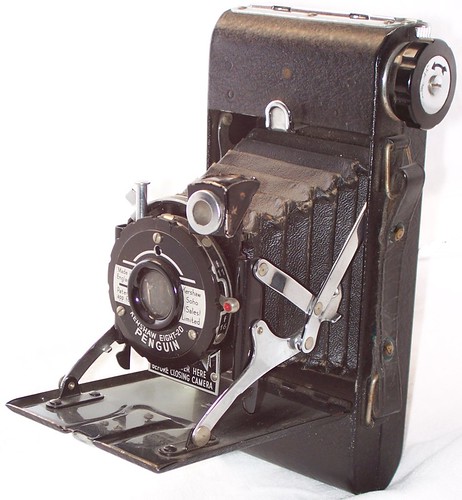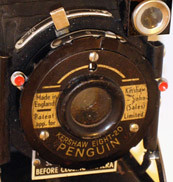Difference between revisions of "Kershaw Eight-20 Penguin"
m (→Links: fixed broken link) |
(twiddling with the prose) |
||
| Line 6: | Line 6: | ||
}} | }} | ||
| − | The '''Kershaw Eight-20 Penguin''' is one of the simpler | + | The '''Kershaw Eight-20 Penguin''' is one of the simpler cameras by [[Kershaw-Soho]] for [[120 film|120 roll film]]. It is a vertical [[folding]] camera. When the bellows is unfolded its front plate is in a fixed position - no moves possible. But despite the camera's simplicity it offers a distance selector with a range from 6 feet to infinity. The distance lever moves the lens/shutter-unit forward or backward, and also moves a pointer on the opposite side of the lens tube. A marker is printed on the lower front side, as well as the direction: "''Set pointer here before closing camera''". The pointer is "here" when the distance lever is moved to infinity, and thus when the lens/shutter-unit is closest to the front plate. The plastic ring around the lens front plate is for the shutter, allowing the choice between the single shutter speed and bulb. The aperture choice is between f11 and f16 - and on some examples, the aperture is fixed with no choice at all. When provided, the aperture lever with the red point moves a second, smaller aperture into or out of the optics. The shutter release has a long travel on which the shutter is cocked before its release. The too-small brilliant viewfinder can be rotated by about 90 degrees for vertical and horizontal exposures. Further features are the easily removable camera back, the [[bakelite]] film winding knob, a stilt foldable from the camera door, and of course a [[red window|red exposure counting window]] in the camera back. Maybe the robust metal body with metal door has preserved many of these cameras, which were introduced in 1951. |
{{Flickr_image | {{Flickr_image | ||
|image_source= http://www.flickr.com/photos/24225011@N04/2380826711/in/pool-camerapedia/ | |image_source= http://www.flickr.com/photos/24225011@N04/2380826711/in/pool-camerapedia/ | ||
|image= http://farm3.static.flickr.com/2005/2380826711_296d19a396.jpg | |image= http://farm3.static.flickr.com/2005/2380826711_296d19a396.jpg | ||
|image_align= left | |image_align= left | ||
| − | |image_text= An | + | |image_text= An alternative lens plate design, with<br />lever [[shutter release]] in place of the<br />"plunger" on the above picture, and no<br />aperture adjustment. The red lever on the<br />right merely cancels the T setting. |
}} | }} | ||
Revision as of 07:22, 20 April 2008

|
The Kershaw Eight-20 Penguin is one of the simpler cameras by Kershaw-Soho for 120 roll film. It is a vertical folding camera. When the bellows is unfolded its front plate is in a fixed position - no moves possible. But despite the camera's simplicity it offers a distance selector with a range from 6 feet to infinity. The distance lever moves the lens/shutter-unit forward or backward, and also moves a pointer on the opposite side of the lens tube. A marker is printed on the lower front side, as well as the direction: "Set pointer here before closing camera". The pointer is "here" when the distance lever is moved to infinity, and thus when the lens/shutter-unit is closest to the front plate. The plastic ring around the lens front plate is for the shutter, allowing the choice between the single shutter speed and bulb. The aperture choice is between f11 and f16 - and on some examples, the aperture is fixed with no choice at all. When provided, the aperture lever with the red point moves a second, smaller aperture into or out of the optics. The shutter release has a long travel on which the shutter is cocked before its release. The too-small brilliant viewfinder can be rotated by about 90 degrees for vertical and horizontal exposures. Further features are the easily removable camera back, the bakelite film winding knob, a stilt foldable from the camera door, and of course a red exposure counting window in the camera back. Maybe the robust metal body with metal door has preserved many of these cameras, which were introduced in 1951.

|
| An alternative lens plate design, with lever shutter release in place of the "plunger" on the above picture, and no aperture adjustment. The red lever on the right merely cancels the T setting. |